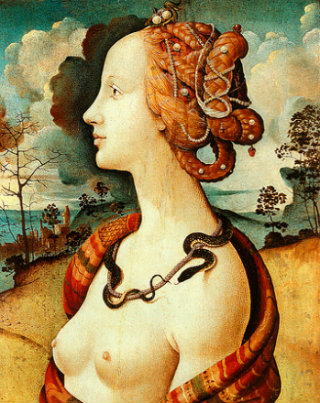The History of Art And The Curious Lives of Famous Painters
|
||||
|
About the Artist Piero di Cosimo was among the great Florentine masters of the 15th century. He was active in various cities of central Italy, notably Arezzo, Florence, Orvieto, Perugia, and Rome. According to Vasari, Piero di Cosimoi was an odd sort who lived off boiled eggs, was inordinately frugal and behaved in strange and eccentric ways. He is famous for his Classical mythological themes and strange creatures of his own imaginings. His figures fen have bizarre almost malicious expressions as if they are mad. Piero di Cosimo differed from previous Florentine painters and his work seems more in tune with the painters of the Northern Renaissance. 'Mystical Marriage of St. Catherine of Alexandria' circa.1493, was his greatest masterpiece. In later years the artist fell under the spell of a notorious self-proclaimed prophet called Savonarola. Under the puritanical influence of Savonarola, Piero di Cosimo's artworks lost much of their magic and became less original. Savonarola sermonized before huge throngs with fiery passion and quickly earn enormous influence over not only the common peasant but artists, writers and the ruling elites. Many of his followers declared him a prophet. Savonarola was anti-humanistic and detested poetry, literature, perfume, art and anything that was vaguely fun. Savonarola declared "They have built up a new Church after their own patter. Go to Rome and see! In the mansions of the great prelates there is no concern save for poetry and the oratorical art. Go thither and see!" He encouraged painters and patrons to burn all artworks that did not conform to his strict code of morality. Thousands of the greatest masterpieces ever created by some of the giants of renaissance art were burned in his notorious Bonfire of the Vanities.
Upon the death of his arch enemies Pope Innocent VIII and Lorenzo de Medici a political power vacuum developed and Savonarola became ruler of the city of Florence. With the help of his followers he ruled with an iron hand, installing a Taliban style rule that outlawed gambling, decadent clothing and sentenced homosexuals and adulterers to death. He stated that the syphilis epidemic was Gods punishment upon backsliders and transgressors. Followers of the radical Friar went on frequent destructive rampages destroying anything that did not conform to Savonarola's militant conception of theology and Christian morality. After a time the people of Florence had had enough of his madness and puritanical laws. In 1498 Sandoval was charged with sedition, uttering false prophesies and various religious transgressions. He was charged, jailed and horrifically tortured for several days but never recanted his words. A trial of sorts was held and he was declared guilty. Sandoval and two of his loyal Dominican disciples were hanged from a huge cross and burned until nothing but ashes remained. During the burning his supporters chanted "Charity is extinct, Love of God is no more. All are lukewarm; And without living faith. . . .Alas! the Saint is dead! Alas! O Lord! Alas! Thou hast taken our Prophet And drawn him to thyself." After Savonarola's death the artists and art of Florence continued to evolve and thrive.
|
||||
|
About The High Renaissance Period Artists of the Renaissance were elevated in social standing and their art was no longer looked upon as simple handicrafts, but as divinely inspired creations. The spirit of an era awoke, revitalized with knowledge and creativity. Although art still served a specific functions, which were primarily religious, painters added more of their individual spirit and personal vision to their creations. John Ruskin, famous art historian stated, "The art of any country is the exponent of its social and political virtues . The art, or general productive and formative energy, of any country, is an exact exponent of its ethical life. you can have noble art only from noble persons, associated under laws fitted to their time and circumstance." The major painters of the Renaissance were not only artists but men of great genius who gave the world their great intellectual gifts. Florentine and Venetian painting were both formed by extraordinary personalities. These independent creative geniuses tackled mathematical, artistic and philosophical problems of the highest interest, and presented solutions that have never lost their value. The sense of humanism pervading renaissance painting is still palpable. The painters touched on a multitude of issues regarding the human condition - death, love, reason, religion, universal morality, social problems. |
||||
|
Key Descriptive Words and Phrases associated with the Renaissance Movement - rebirth, rediscovery of the classical world, publication of Della Pittura, a book about the laws of mathematical perspective for artists, sfumato, chiaroscuro, Savonarola, spiritually significant, illuminated manuscript, idealized biblical themes, scriptorium, illuminator, plague, Age of Discovery, curiosity about the natural world, realistic use of colours and light, Bonfire of the Vanities, Old Testament stories, ethereal and foggy backgrounds, Gospel parables, romanticized landscapes, Christian symbolism. Require more facts and information about Piero di Cosimo and the artists of the renaissance era? Poke around every nook and cranny of the known universe for information this subject. Search Here © HistoryofPainters.com If you like this page and wish to share it, you are welcome to link to it, with our thanks. If you feel you have worthwhile information you would like to contribute we would love to hear from you. We collect essential biographical information and artist quotes from folks all over the globe and appreciate your participation. When submitting please, if possible, site the source and provide English translation. Email to millardmulch@gmail.com |
